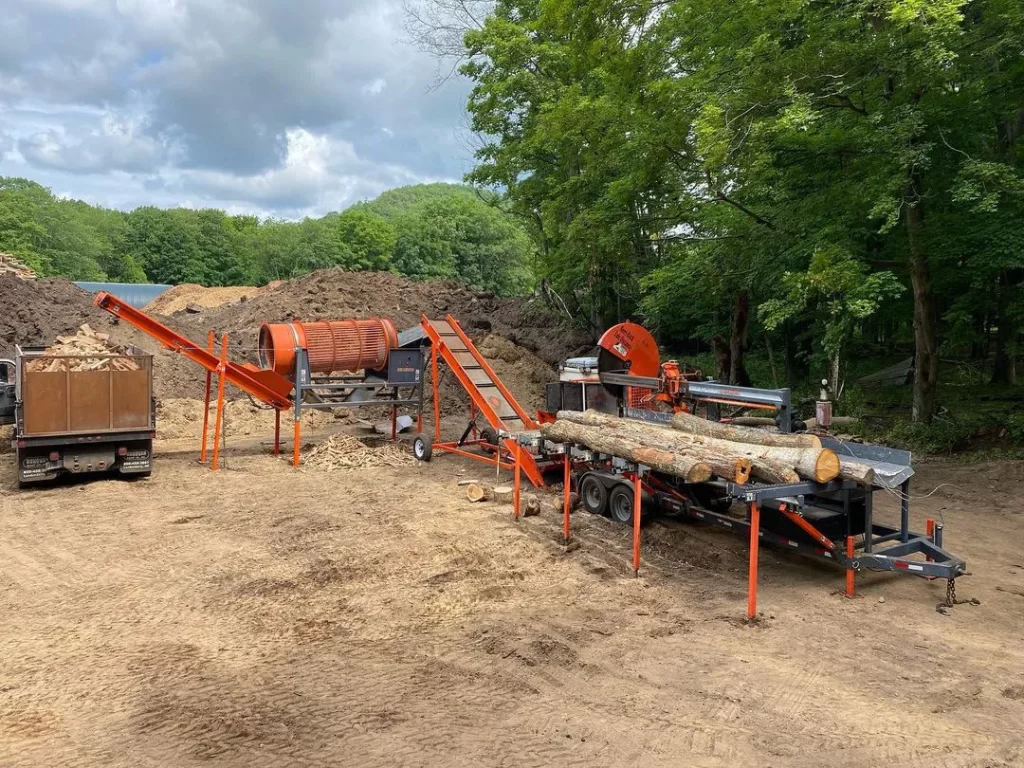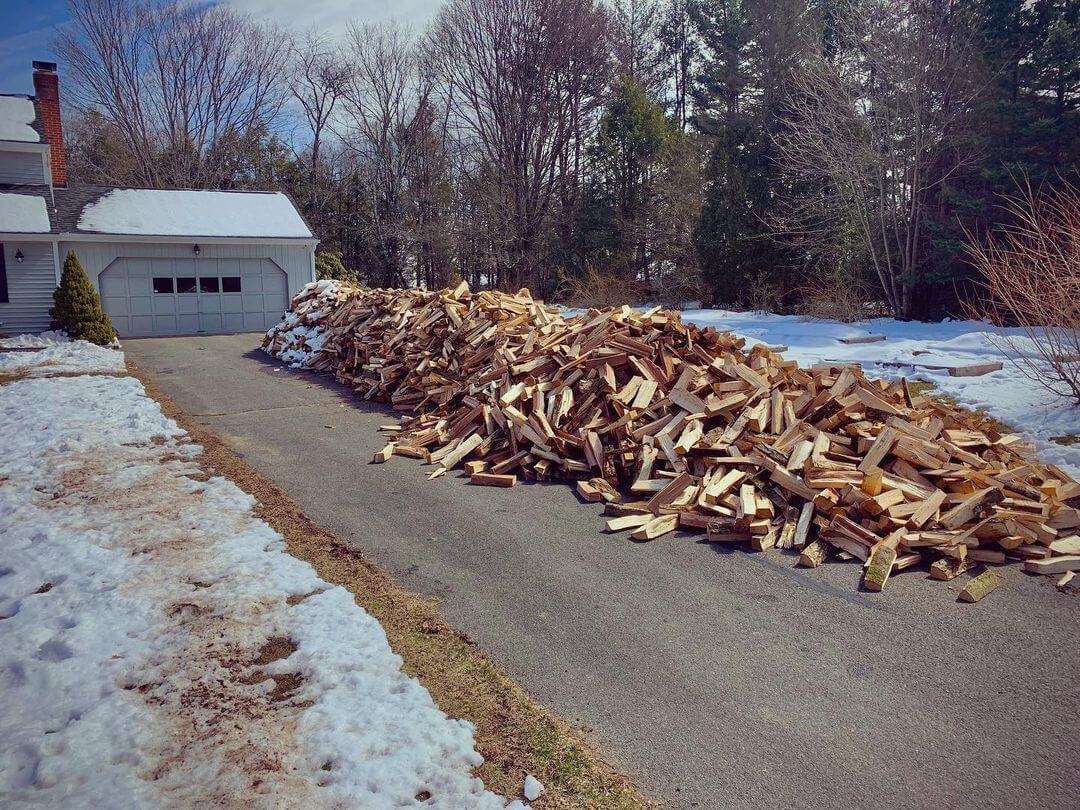Proper Firewood Storage: Essential Tips for Connecticut Homeowners
There’s nothing quite like the warmth and ambiance of a crackling fire on a cold Connecticut evening. But here’s the thing: the difference between a cozy, efficient fire and a smoky, frustrating experience often comes down to how you store your firewood.
When you store firewood correctly, you’re protecting your investment and ensuring that each piece burns hot and clean. Poor storage can lead to wet wood that won’t light, increased creosote buildup in your chimney, pest problems, and even structural damage to your home. In this guide, we’ll walk you through everything you need to know about storing firewood safely and keeping it dry. Whether you’re working with premium seasoned hardwood for your indoor fireplace or softwood for your outdoor fire pit, these tips will help you maintain a dry, ready-to-burn supply all season long.

Why Proper Firewood Storage Matters
Wood with high moisture content won’t burn efficiently – you’ll struggle to get it lit, it’ll produce more smoke than heat and you’ll constantly be adding logs to maintain even a modest fire. Wet or improperly stored firewood also creates the perfect environment for mold and fungi, attracts pests like termites and carpenter ants and produces more creosote – a flammable substance that builds up in your chimney and increases fire risk.
On the flip side, properly stored firewood burns cleaner, hotter and more efficiently. You’ll use less wood to generate more heat, your supply lasts longer and you get better value from every cord. According to the University of Connecticut Extension, properly seasoned and stored firewood should have a moisture content below 20% for optimal burning.
Choosing the Right Location for Your Firewood
Location is everything when it comes to firewood storage. Experts recommend keeping your main firewood stack at least 20 to 30 feet away from your home and other structures. This distance discourages pests from migrating into your home, reduces fire risk and prevents moisture from affecting your home’s siding or foundation. You can maintain a small secondary stack closer to your door for convenience – just limit it to a few days’ worth of wood.
Choose a spot that receives plenty of sunlight and good wind exposure. Direct sunlight helps dry out surface moisture and prevents mold growth, while natural air circulation is one of the most effective tools for keeping firewood dry. A location with southern or western exposure works best in our region.
Never stack firewood directly on the ground. Ground contact absorbs moisture from the soil and invites insects and rodents. Instead, elevate your firewood at least 3 to 4 inches using pallets, commercial racks, concrete blocks, or treated lumber. Avoid stacking against siding, fences, or trees, and stay clear of areas under roof drip lines or dense tree cover.
For more detailed stacking techniques, check out our comprehensive guide to stacking and storing firewood.
Best Practices for Stacking Firewood
How you arrange your firewood matters just as much as where you put it. Start with a solid, level foundation using pallets or treated lumber. The traditional row stack method works best: arrange split logs in neat rows with cut ends facing outward, keeping your stack about 4 feet high. Any higher risks instability; any lower wastes space.
For the ends of your stack, use the crisscross method—alternate layers at 90-degree angles to create stable bookends. Stack only one row deep to ensure airflow reaches all pieces. Leave small gaps between logs so air can flow freely around each piece.
Most experts recommend stacking wood bark-side up, as the bark acts as a natural shingle to shed water. The Connecticut Agricultural Experiment Station recommends allowing at least six months of drying time for split hardwood in proper storage conditions.
Covering Your Firewood: What Works and What Doesn’t
Here’s the golden rule: cover the top, leave the sides open. When you completely wrap firewood in tarps or plastic, you create a moisture trap. Instead, think of your cover as a roof, not a tent. Protect from rain and snow falling from above but let the sides remain exposed to air and wind.
A simple tarp works great if secured properly with bungee cords or rope. Make sure it drapes down far enough to protect the top layers but doesn’t extend to the ground. Metal roofing panels are excellent for permanent setups, and purpose-built firewood covers are designed specifically for this task. Avoid plastic sheeting that completely encloses your stack.
Your covering approach can shift with seasons. During humid summer months, you might use minimal covering to maximize airflow. Once fall arrives and rain becomes more frequent, add top coverage. In winter, keep your stack covered to prevent snow accumulation while maintaining those open sides.
Storage Solutions and Maintenance
Not everyone has the same space available. If you have a spacious yard, you can set up multiple storage locations and organize by wood type or age. For smaller properties, compact vertical racks maximize height rather than width and can fit in corner spaces or along shed walls (leave several inches between wood and structures).
For convenience, maintain a small secondary storage area near your entry point with a two or three-day supply. When bringing wood inside, only bring what you’ll burn that day – never stockpile large amounts indoors. For more tips on burning, check out our guide on how to burn firewood in a fireplace.
Follow the “first in, first out” principle with your supply. Mark deliveries with dates to ensure you’re using the oldest, driest wood first. Check your stack every few weeks for signs of excessive moisture, mold or pest activity. Watch for sawdust piles, holes in bark or visible insects – catching problems early prevents them from spreading.
Common Mistakes to Avoid
Avoid these frequent errors: storing too close to your home, inadequate elevation off the ground, over-covering or blocking airflow, mixing delivery batches without organization, ignoring pest signs, stacking too high (over 4 feet), and treating green wood the same as seasoned wood. Each of these mistakes can compromise your wood’s quality and your home’s safety.
Getting Quality Firewood Delivered in Simsbury
All the storage techniques in the world can’t fix poor-quality firewood. At Thrive Farm, we offer two options: firewood for indoor use features 100% native hardwood species, properly seasoned and cut to 16-18 inch lengths – perfect for fireplaces and wood stoves. For outdoor use, we offer 100% native softwood species, ideal for fire pits and campfires with easy ignition and pleasant aroma.
Both options come with convenient delivery throughout Simsbury and the surrounding area. When you combine quality, seasoned wood with proper storage, you’ll have dry, ready-to-burn firewood whenever you need it. Learn more at our Simsbury firewood page.
Conclusion: Store Smart, Burn Better
Proper firewood storage requires thoughtful planning and simple practices: choose a location with good sun and wind exposure, keep wood elevated, stack loosely to promote airflow and cover only the top. Keep your main stack 20 to 30 feet from your home, inspect regularly and rotate your supply. When you start with quality, properly seasoned firewood and store it correctly, every fire becomes easier to light and burns cleaner and hotter.
Ready to Stock Up on Premium Firewood?
Thrive Farm delivers seasoned hardwood and softwood firewood throughout Simsbury and the surrounding area. Our wood arrives cut to the perfect length, properly seasoned, and ready to store.
Whether you need hardwood for your indoor fireplace or softwood for your outdoor fire pit, we’ve got you covered with convenient delivery right to your door.
